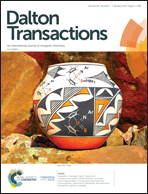A heterometallic metal–organic framework based on multi-nuclear clusters exhibiting high stability and selective gas adsorption†
Abstract
The design and synthesis of porous heterometallic metal–organic frameworks (MOFs) with high thermal and chemical stability is a challenging task at present. In this work, by the heterometallic cooperative crystallization (HCC) approach, an original heterometallic MOF based on a tetra-carboxylic ligand has been solvothermally synthesized [In6O3Tb3O(CBDA)3]·18DMF·3H2O (In/Tb-CBDA) [CBDA = 5,5′-(carbonylbis(azanediyl))-diisophthalic acid, DMF = N,N-dimethylformamide]. The framework of In/Tb-CBDA is cooperatively assembled from the rarely reported tetra-nuclear In4O2(COO)4 and tri-nuclear Tb3O(COO)6 clusters, and an organic ligand. Topological analysis indicates that In/Tb-CBDA exhibits a new (4,4,6)-connected topology with the Schläfli symbol (4·63·82)6(43·69·83)2(62·84)3. Noteworthy, forming multi-nuclear metal clusters prompts the framework to maintain high stability under the conditions of heating to 150 °C, exposure to air, and soaking in acidic and basic aqueous solutions for 12 h. After desolvation, In/Tb-CBDA shows permanent porosity proved by N2 adsorption isotherms. In addition, theoretical ideal adsorption solution theory (IAST) calculation indicates that In/Tb-CBDA displayed high selective adsorption of CO2/CH4, C2H6/CH4 and C3H8/CH4 at room temperature. This work shows a striking example of a porous heterometallic MOF material with high thermal and chemical stability, which exhibits high-efficiency selective gas adsorption behaviour.



 Please wait while we load your content...
Please wait while we load your content...